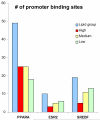Global gene expression analysis reveals evidence for decreased lipid biosynthesis and increased innate immunity in uninvolved psoriatic skin
- PMID: 19571819
- PMCID: PMC2783967
- DOI: 10.1038/jid.2009.173
Global gene expression analysis reveals evidence for decreased lipid biosynthesis and increased innate immunity in uninvolved psoriatic skin
Abstract
Psoriasis is a genetically determined inflammatory skin disease. Although the transition from uninvolved into lesional skin is accompanied by changes in the expression of multiple genes, much less is known about the difference between uninvolved skin from psoriatic patients as opposed to skin from normal individuals. Multiple biochemical and morphological changes were reported decades ago in uninvolved psoriatic skin but remain poorly understood. Here, we show dysregulation of 223 transcripts representing 179 unique genes in uninvolved psoriatic skin, 178 of which were not previously known to be altered in their expression. The proteins encoded by these transcripts are involved in lipid metabolism, antimicrobial defenses, epidermal differentiation, and control of cutaneous vasculature. Cluster analysis of transcripts with significantly altered expression identified a group of genes involved in lipid metabolism with highly correlated gene expression. Promoter analysis showed enrichment for binding sites of three transcription factors; peroxisome proliferator-activator receptor alpha (PPARA), sterol regulatory element-binding protein (SREBF), and estrogen receptor 2 (ESR2), suggesting that the coordinate regulation of lipid metabolic genes may be related to the action of these factors. Taken together, our results identify a "pre-psoriatic" gene expression signature, suggesting decreased lipid biosynthesis and increased innate immunity in uninvolved psoriatic skin.
Figures






Similar articles
-
The Keratinocyte Transcriptome in Psoriasis: Pathways Related to Immune Responses, Cell Cycle and Keratinization.Acta Derm Venereol. 2019 Feb 1;99(2):196-205. doi: 10.2340/00015555-3066. Acta Derm Venereol. 2019. PMID: 30320872
-
RNA-seq identifies a diminished differentiation gene signature in primary monolayer keratinocytes grown from lesional and uninvolved psoriatic skin.Sci Rep. 2017 Dec 22;7(1):18045. doi: 10.1038/s41598-017-18404-9. Sci Rep. 2017. PMID: 29273799 Free PMC article.
-
Integrative methylome and transcriptome analysis to dissect key biological pathways for psoriasis in Chinese Han population.J Dermatol Sci. 2018 Sep;91(3):285-291. doi: 10.1016/j.jdermsci.2018.06.001. Epub 2018 Jun 9. J Dermatol Sci. 2018. PMID: 29914851
-
MiRNA expression in psoriatic skin: reciprocal regulation of hsa-miR-99a and IGF-1R.PLoS One. 2011;6(6):e20916. doi: 10.1371/journal.pone.0020916. Epub 2011 Jun 7. PLoS One. 2011. PMID: 21687694 Free PMC article.
-
Transcriptome Profiling Analyses in Psoriasis: A Dynamic Contribution of Keratinocytes to the Pathogenesis.Genes (Basel). 2020 Sep 30;11(10):1155. doi: 10.3390/genes11101155. Genes (Basel). 2020. PMID: 33007857 Free PMC article. Review.
Cited by
-
Emerging roles of a chemoattractant receptor GPR15 and ligands in pathophysiology.Front Immunol. 2023 Jun 30;14:1179456. doi: 10.3389/fimmu.2023.1179456. eCollection 2023. Front Immunol. 2023. PMID: 37457732 Free PMC article. Review.
-
Transcriptome analysis of psoriasis in a large case-control sample: RNA-seq provides insights into disease mechanisms.J Invest Dermatol. 2014 Jul;134(7):1828-1838. doi: 10.1038/jid.2014.28. Epub 2014 Jan 17. J Invest Dermatol. 2014. PMID: 24441097 Free PMC article.
-
Full-Length Transcriptome Sequencing Analysis of Differentially Expressed Genes and Pathways After Treatment of Psoriasis With Oxymatrine.Front Pharmacol. 2022 Jun 3;13:889493. doi: 10.3389/fphar.2022.889493. eCollection 2022. Front Pharmacol. 2022. PMID: 35721124 Free PMC article.
-
What does global gene expression profiling tell us about the pathogenesis of systemic sclerosis?Curr Opin Rheumatol. 2013 Nov;25(6):686-91. doi: 10.1097/01.bor.0000434672.77891.41. Curr Opin Rheumatol. 2013. PMID: 24061076 Free PMC article. Review.
-
The genetics of human skin disease.Cold Spring Harb Perspect Med. 2014 Oct 1;4(10):a015172. doi: 10.1101/cshperspect.a015172. Cold Spring Harb Perspect Med. 2014. PMID: 25274756 Free PMC article. Review.
References
-
- Bowcock AM, Shannon W, Du F, Duncan J, Cao K, Aftergut K, et al. Insights into psoriasis and other inflammatory diseases from large-scale gene expression studies. Hum Mol Genet. 2001;10:1793–1805. - PubMed
-
- Braun-Falco O. Dynamics of Growth and Regression in Psoriatic Lesions: Alterations in the skin from Normal into a Psoriatic Lesion, and during Regression of Psoriatic Lesions. Stanford University Press; Stanford, California: 1971. pp. 215–237.
-
- Candi E, Schmidt R, Melino G. The cornified envelope: a model of cell death in the skin. Nat Rev Mol Cell Biol. 2005;6:328–340. - PubMed
Publication types
MeSH terms
Substances
Grants and funding
LinkOut - more resources
Full Text Sources
Other Literature Sources
Medical

